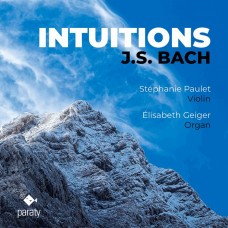|
巴哈: 直覺(巴哈作品及改編曲)
史蒂芬妮·波雷 小提琴
伊麗莎白·蓋格 管風琴
此二重奏的目的是強調巴洛克音樂中活潑和即興的元素. 透過轉調(modulation)速度和施加在琴弦上的壓力, 讓小提琴拉出自己的色調, 在現有的管風琴音域中加入了弦樂器. 利用夏賀勒(Charolles)管風琴的獨特設計讓這種混合呈現出美麗的聲音織體(sound texture).
管風琴彈奏是在巴哈家族中每日會用到的手藝, 是巴哈在安哈特邦克藤(Anhalt-Köthen)宮廷和萊比錫齊瑪曼咖啡館中用來編寫和演奏的樂器, 或是經常在他家裡被他的孩子, 學生 寄宿者和各界知名的朋友所彈奏的樂器. 在許多方面來說, 家庭音樂(Hausmusik,或室內音樂)是巴哈維持他週邊朋友關係的聲音倒影.
Exploring J.S. Bach's works with new eyes, chamber music, intuition and reinterpretation:
Our duo aims to shine a light on the lively and improvised elements of baroque music. Through modulations of speed and pressure on its strings, the violin brings into play its own colours, adding the presence of string instruments to the existing organ register. The unique design of Charolles' organ (see Quentin Blumenroeder's text) renders the blend of these sound-textures beautifully.
was an everyday craft in the Bach family: the one Bach undertook to compose and have performed at the court of Anhalt-Coethen and later at the Cafe Zimmermann in Leipzig, or the one permanently performed at his home by his children, pupils, boarders or friends of all fame. In many ways, Hausmusik was the sonic reflection of the relationship Bach maintained with those around him.
Sonata per il Violino Solo e Basso Continuo BWV 102
1. Adagio 04:24
2. Vivace 01:07
3. Largo 02:48
4. Presto 01:38
5. Sinfonia N° 7 in E Minor BWV 793. 01:54
6. Sinfonia N°3 in D Major BWV 789. 01:16
7. Choral Nun komm, der Heiden Heiland BWV 659. 04:16
8. Sinfonia N° 8 in F Major BWV 794. 01:18
9. Sinfonia N° 13 in A Minor BWV 799. 01:28
Sonata IV in E Minor BWV 528
10. Adagio, Vivace 02:32
11. Andante 05:00
12. Un poco Allegro 02:29
13. Sinfonia N° 11 in G Minor BWV 797. 02:05
14. Sinfonia N° 2 in C Minor BWV 788. 01:59
15. Sinfonia N° 15 in B Minor BWV 801. 01:34
Partita in B Minor BWV 1002
16. Allemanda 03:35
17. Double 01:49
18. Corrente, Double 06:27
19. Sarabande, Double 03:32
20. Tempo di Borea, Double 03:33
21. Choral Wachet auf ruft uns die Stimme in E Flat Major BWV 645. 04:31" |
|


